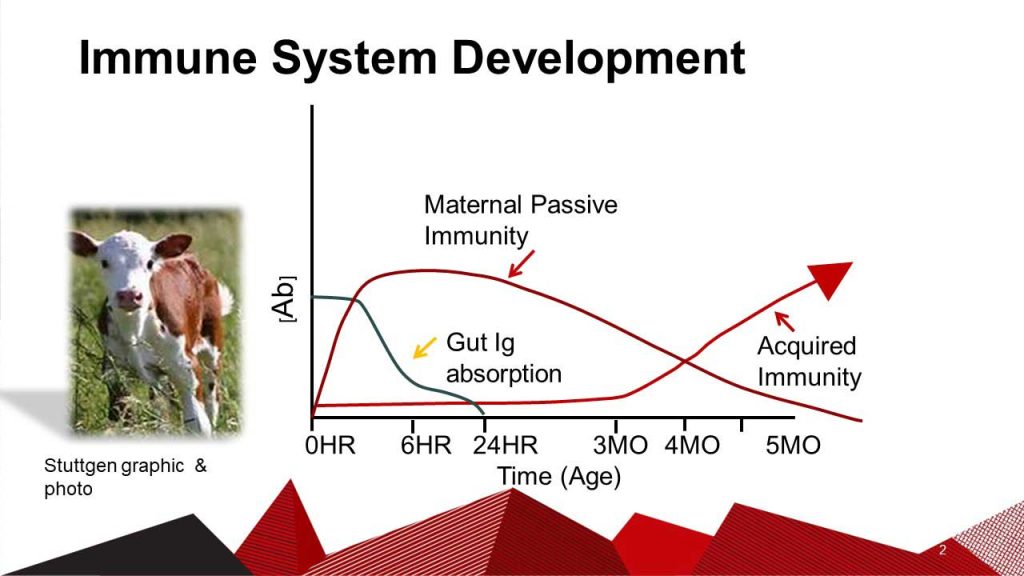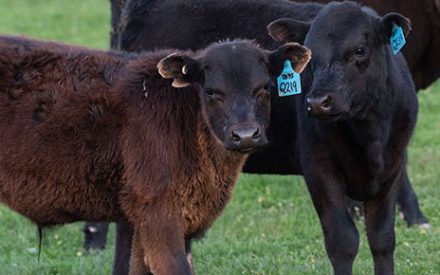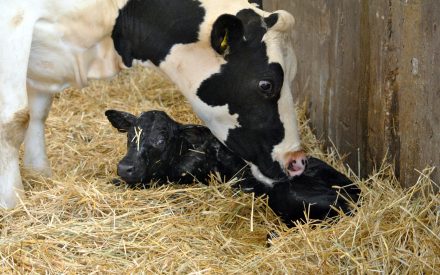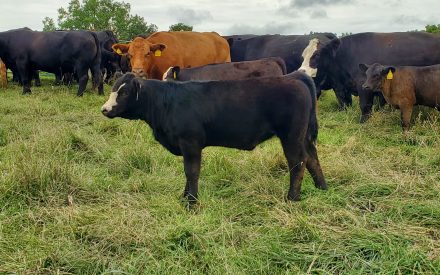Table of Contents
- Introduction
- Perinatal management: Immediately before, when, and after the calf is born
- Time vaccinations to match the immune system’s maturity
- Enteric Diseases
- Enteric viral diseases
- Enteric protozoan diseases
- Respiratory viral disease
- Respiratory bacterial disease
- Brucella vaccination
- Summary
- References
- Reviewer
- Author
- Download this article / factsheet

Introduction
The goals for vaccinating beef calves are to protect the calf against potential disease-causing agents, to begin to provide protection for the calf’s entry into the adult herd or the feedlot, and to increase or at least maintain herd immunity.
This article discusses the common calfhood diseases and their associated vaccines. Product names and administration protocols are not discussed. Rely on the veterinarian who best understands your operation – the one with whom you have a Veterinary Client Patient Relationship (VCPR) – for advice about product selection and for designing your operation’s vaccine protocol. Beef calf health is maintained by sound management programs which include vaccination strategies. Vaccination never replaces management.
Perinatal management: Immediately before, when, and after the calf is born
Calf health relies on the dam’s nutrition during the last 60 days of gestation. This is especially true for first-calf heifers and late-gestation cattle during the coldest part of Wisconsin’s winter or hot, humid summers.
Cows and heifers should calve at a body condition score of 5 to 6 or 6.5. Either too thin or too fat sets the calf up for increased health-related events including dystocia (difficult calving). Body condition should be evaluated and recorded three times a year: 60 to 90 days before calving, at calving, and weaning. Scoring before calving allows you enough time for ‘emergency feeding’ if needed. As the fetus is also growing, it can be difficult to put weight on the cow, especially during weather extremes or when quality feeds are limited.
The dam’s immunity does not cross the placenta. Instead, it’s a passive transfer as her antibodies and other immune factors are concentrated in her udder for the calf to ingest. Colostrum production begins during her last trimester and is completed before calving. Passive transfer is only available to the calf during its first 24 hours of life. Passive transfer fails when the calf does not ingest or absorb colostrum. Newborns must receive 10% of their body weight of good-quality colostrum within 24 hours of birth, preferably within six hours. Time to stand and nurse are traits correlated to bull genetics. Monitor calvings to make sure the calf is up and nursing soon after birth as colostrum quantity declines every hour the calf is not nursing. Calve in a clean environment, so the calf is not exposed to pathogens in the bedding, mud, or from suckling dirty teats.
Narrow calving intervals help create similarly aged calves facing disease challenges with similarly developed immune systems. As calves age, they are exposed to pathogens which they may give to younger, immune naïve calves. As much as possible, keep similarly aged calves and their mothers together as separate smaller groups, and don’t mix with calves that are two to three weeks older. Wait to combine groups back into one herd as the youngest calves in each group turn a month old (Sandhills Calving System).
To prevent navel infection and subsequent septicemia (an infection that spreads to the liver, lungs, and joints), newborn calf navels should be disinfected immediately after birth. Place identifying ear tags and test for Bovine Viral Diarrhea (BVD) at this time.
If your herd has a history of neonatal diarrhea (calf scours), you may wish to consider vaccinating late-gestation cattle with products to boost the protective immunoglobulin (Ig) the cow secretes into her colostrum. Scour vaccines are available for E. coli K99, Rotavirus, Coronavirus, and Clostridium perfringens. Antibody concentration into the udder begins five weeks pre-fresh, with peak concentration deposited two weeks before calving; therefore, vaccinations to boost colostral immunity need to be administered to the dam eight weeks before she calves. Calf protection provided by vaccines hinges on the timely ingestion of colostrum.
Newborn calves can be vaccinated with oral products to help prevent scours from the agents mentioned above. These vaccines provide short-term, localized immunity to protect the calf during its first weeks of life. Some viral products must be given orally before the ingestion of colostrum. Talk with your veterinarian and read the product label to ensure proper use.
Time vaccinations to match the immune system’s maturity

Calves are born with a functional, but naïve immune system. For the first 3 to 4 months of life, the calf is dependent on the passive transfer of antibodies and immune factors obtained from its mother through colostrum.
The ability of the calf’s intestine to absorb maternal antibodies (depicted as Gut Ig absorption in Figure 1) is drastically reduced by 6 hours and completely closed by 24 hours. The maternal passive immunity absorbed into the calf’s blood and lymphatic systems peaks by 24 hours, steadily declines over four months, and is exhausted by the time the calf is 6 months old.
As calves age, their ability to respond to pathogens or vaccines (their acquired immunity) steadily increases. Systemic vaccines (given intramuscularly or subcutaneously) are poorly responded to by calves less than three months old, and they may be blocked by the presence of colostrum-derived maternal antibodies. The calf can begin to acquire immunity by the time puberty is reached (four to six months of age).
Notice the cross-over point in Figure 1 that occurs at four to five months of age as passive immunity is waning, and acquired immunity is increasing. This cross-over often happens during weaning and explains why the calf is susceptible to respiratory infection at this time. Preconditioning and vaccination help protect the calf from respiratory disease. You want protective vaccine antibodies to be present as weaning occurs, so make sure both primary and booster doses are given at least two weeks before the weaning date.
Immune maturation that begins at puberty is not complete until the calf reaches 12 months of age. Some respiratory viruses also cause reproductive disease. Respiratory/reproductive viral vaccines administered before weaning begin the vaccine history needed to prepare herd replacements for a successful reproductive career. However, calves’ immunity between five to 12 months of age is not reproductively programmed. Fetal protection is not provided by vaccinations given to young calves. To achieve such duration, yearlings (10 to 12 months of age) must receive reproductive vaccination or be boostered to those given earlier.
Enteric Diseases
Diarrhea (scours) is the predominant symptom of enteric (intestinal) diseases that may be seen early in a calf’s life. Agents that cause scours have a predictable age distribution. Lab diagnosis is needed to identify the organism causing the calf scours. E. coli and Clostridium bacteria, Rotavirus, and Coronavirus challenge calves during their first week of life. Cryptosporidia and Coccidia protozoa as well as Salmonella bacteria typically challenge calves over one to two weeks of age. Evaluate maternity area management and colostrum passive transfer if young calves suffer enteric diseases.
| Organism | Calf Age | Predominant Symptom |
|---|---|---|
| E. coli K99 bacteria | < 5 days of age | Acute death, often without scours; septicemia |
| Chronic E. coli | Birth – 3 mo. | Mucoid scours, polyarthritis, unthriftiness |
| Clostridium perfringens | 5 – 10 days | Sudden death, bloody diarrhea, intestinal bloat, abdominal pain, convulsions |
| Salmonella bacteria | 2 – 6 weeks | High fever (>104⁰F), septicemia, bloody diarrhea, acute death, pneumonia. Chronic disease and sub-clinical carriers in the herd |
| Rotavirus | 1-2 weeks | Watery scours, dehydration |
| Coronavirus | 1 – 2 weeks | Watery scours, dehydration |
| Cryptosporidium | 5 – 35 days | Watery white scours, dehydration |
| Eimeria (coccidia) | 21 days – 2 yrs. | Soft stools, poor weight gain, no loss of appetite |
E. coli and its numerous strains are bacteria normally found in cattle intestines and are passed in feces. Whether or not E. coli causes disease depends on the virulence of the strain, the immune status of the calf (successful or failed passive transfer), stress, wet environment, and poor diet. The enterotoxigenic strain E. coli K99 may cause sudden death and scours in calves less than three days of age; often the toxin kills the calf before scours are observed. Vaccines are available to be given to either late gestation cattle or orally to newborn calves to prevent enterotoxigenic E. coli K99 scours.
Vaccines are not as effective against the E. coli strain that causes chronic, mucoid diarrhea in four-day to three-month-old calves. Infected calves do not gain well, are unthrifty, and are susceptible to other infections. Chronic disease, polyarthritis, meningitis, and convulsions may occur. Disinfecting navels immediately after birth helps protect the calf from E. coli septicemia, as does minimizing the amount of manure a newborn calf ingests.
Clostridia may be found under anaerobic conditions (lacking oxygen) in soil, mud, and the intestinal tracts of cattle. Different geological areas have varying prevalence. Clostridia may cause death from the endotoxins produced under favorable conditions following inoculation into wounds or when the intestinal tract supports their overgrowth.
Clostridium perfringens produces at least 12 different toxins named into types A to E. Well-fed calves from one week to one month of age may develop enterotoxemia when intestinal conditions favor the overgrowth of C. perfringens type A, B, and C toxins.
Vaccines containing C. perfringens types are available to be given to both late gestation cows and newborn calves. Toxoid and antitoxin products are also available. Talk with your veterinarian to understand how to use these products correctly.
Clostridia vaccines should be given to prepare weaned calves for entry into the feedlot or into the reproductive herd. Seven- and eight-way vaccine products are available which contain combinations of Clostridium chauvoei (blackleg), Cl. septicum (malignant edema), Cl. novyi, and/or Cl. sordellii (2– or 4-way), and Cl. perfringens types C and D (enterotoxemia, overeating). Check the label, Cl. tetani may or may not be included.
Tetanus is not as severe a problem in cattle as it is in goats, sheep, and horses. Practicing surgical (knife-cut) castration helps prevent Clostridium infection and, in most cases, vaccination against tetanus is not needed.
Salmonella is another soil-borne bacterium capable of causing high fever, septicemia, bloody diarrhea, and acute death in calves older than 10 days of age. Salmonella may also cause pneumonia. Cattle that appear to recover from Salmonella may harbor it and become subclinical carriers that threaten the herd.
Salmonella has numerous strains (serovars), and vaccine products are available to protect cattle from the various strains. It is most helpful to have the strain affecting your calves identified by a lab so the correct vaccine product can be used.
Follow vaccine use and storage directions. Most require refrigeration; make sure your refrigerator maintains 45⁰F. Some vaccines have withdrawal times. Do not use expired vaccines. “Use Entire Bottle” means discarding unused product after you open the bottle. Use MLV vaccines within one hour of mixing and discard unused mixture. Use the proper needle for the product viscosity and animal size.
Enteric viral diseases
Rotavirus and Coronavirus may destroy the intestine’s absorptive properties, causing secretory diarrhea usually in 10-day-old calves. While not fatal in and of themselves, the resulting diarrhea and dehydration cause the calf to be susceptible to other diseases. Intestinal acidosis may also result which causes the calf to lose its suckle reflex. The calf soon dehydrates and starves to death.
Vaccines given to late gestation cows often contain Rotavirus. After vaccinating the dam, calf protection hinges on timely ingestion of colostrum. It is also possible to vaccinate the calf at birth against Rotavirus and Coronavirus by administering oral vaccines. Work with your veterinarian to understand how to use these products correctly.
Enteric protozoan diseases
Cryptosporidium and Eimeria (coccidia) are protozoa that cause diarrhea in calves older than 10 days of age. Vaccines are not available to prevent these infections. Treatments are available for coccidiosis. Preventing fecal contamination of feed and water is key to avoiding problems from these organisms.
Modified live virus (MLV) vaccines contain dehydrated virus that is reactivated once reconstituted. When injected, they replicate for a short time. MLV antibody titers are higher and remain elevated for longer periods than titers produced in response to killed virus vaccines.
Respiratory viral disease
Respiratory disease is most likely to occur in calves that are stressed during marketing and transporting. Infectious Bovine Rhinotracheitis (IBR), Parainfluenza-3 (PI-3), Bovine Viral Diarrhea (BVD), and Bovine Respiratory Syncytial Virus (BRSV) are found everywhere cattle are. They are commonly associated with Bovine Respiratory Disease (BRD). All are included in nearly every viral respiratory vaccine.
IBR is a strain of the Bovine Herpes Virus (BHV-1). Symptoms include high fever, loss of appetite, rapid respiration, and open-mouth breathing. Profuse nasal discharge occurs along with hyperemia of the nostrils and muzzle (“red nose”). IBR-induced conjunctivitis may be misdiagnosed as pinkeye; however, IBR corneal lesions are not centrally located like pinkeye. Latent IBR infection can trigger IBR breaks when the animal is under stress. Vaccinate to produce disease-blocking antibodies before known periods of stress.
Pay attention to the use of modified live virus (MLV) vaccines containing IBR injected into nursing calves. MLV IBR may prevent the dam’s next pregnancy or cause her to abort an early pregnancy. The label will tell you if the vaccine is safe for or around pregnant animals. A new recombinant BHV-1 vaccine shows promise for protecting against BHV-1, BRSV, PI-3, and BVD. This vaccine does not risk cattle pregnancies (Jones and Chowdhury).
Intranasal (killed and temperature-sensitive) IBR vaccines produce mild disease to stimulate the immune system to produce interferon. Interferon is a non-specific immune complex that is secreted along the nasal passages and throat. Interferon protects against a variety of respiratory diseases.
Parainfluenza-3 (PI-3) virus is one of the most common viruses involved in the “shipping fever complex” that often occurs within one to two weeks after calves arrive at feed yards. Uncomplicated PI-3 infections are mild, and the majority are asymptomatic. The economic importance of PI-3 lies in its ability to predispose cattle to bacterial pneumonia.
The virus that causes the most financial impact on cattle operations everywhere is BVD. It is easily transmitted between cattle, has a variable incubation period, and causes profound immunosuppression. BVD causes fever, diarrhea, erosions, or necrosis of mucous membranes of the gastrointestinal tract. BVD often goes unnoticed unless oral erosions are observed.
BVD is frequently diagnosed as “undifferentiated respiratory disease” because fever, nasal discharge, and rapid breathing are predominant symptoms. The greatest economic consequence of BVD however is due to the reproductive diseases it causes. The second greatest economic consequence of BVD is the sub-clinical carrier.
Cattle are primary reservoirs of BVD, and persistently infected cattle maintain the virus in the herd and on feed lots. High protective antibody titers to BVD can be created with multiple doses of killed products or with one or two doses of MLV per year.
Do not rely on vaccination alone to protect your herd from BVD. Herd biosecurity is necessary: purchase cattle, including the bull, who have tested negative for BVD. Screen your breeding herd and test breeding stock as calves, to identify infected animals as soon as possible. Persistently infected cattle may be diagnosed at birth by testing either blood or a sample of skin (ear notch). All persistently infected cattle and calves should be euthanized as soon as they are identified.
Bovine Respiratory Syncytial Virus (BRSV) will infect cattle of all ages. Calves often get sick from it following stressful chute events, for example, when they are separated from their mothers during estrus synchronization and AI breeding. Symptoms include high fever, difficulty breathing, and coughing. Most cases recover spontaneously, but complicated cases in stressed cattle may result in permanent lung damage.
Respiratory bacterial disease
Mannheimia haemolytica, Pasteurella multocida, Histophilus somni, and Mycoplasma bovis are the bacteria commonly associated with BRD. Bibersteinia trehalosi has been emerging as a major cause of cases of acute BRD in cattle. Vaccines are available for Mannheimia haemolytica, Pasteurella multocida, and Histophilus somni and should be considered following a lab diagnosis or if they are a problem in your herd. As part of your preconditioning program, determine which products to use with the buyer of your feeder calves.
Bacterial pneumonia may follow viral infection. To reduce the potential for secondary bacterial infections, manage against viral exposure, and administer viral respiratory vaccines before scheduled stress events. Pneumonia can be prevented by avoiding overcrowded, wet living conditions, and providing optimal ventilation, nutrition, and bunk space.
Brucella vaccination
Vaccinating for Brucella abortus is optional in Wisconsin as we are currently free of this disease. Vaccinate for brucellosis If you are selling or purchasing female breeding livestock interstate or internationally. This vaccine is administered by federally accredited veterinarians to heifer calves between four and 12 months of age; however, many states have more restrictive age requirements for vaccination.
Summary
This article discussed the common calfhood diseases found in Wisconsin. Work with your veterinarian to select products and establish a vaccine protocol that makes sense for your calves and achieves the goals of your operation Perinatal vaccinations help protect young calves from enteric diseases. Pre-weaning vaccinations prime the calf for successful weaning and feedlot performance. Yearling vaccinations foster future reproductive performance.
References
Griffin, D., Chengappa, M., Kuszak, J., McVey, S. Bacterial Pathogens of the Bovine Respiratory Disease Complex, Veterinary Clinics of North America: Food Animal Practice, Volume 26, Issue 2, 2010, Pages 381-394,
ISSN 0749-0720, https://doi.org/10.1016/j.cvfa.2010.04.004.
Jones, C. and Chowdhury, S. Bovine Herpesvirus Type 1 (BHV-1) is an important cofactor in the Bovine Respiratory Disease Complex. Vet Clin Food Anim 26 (2010) 303–321. doi:10.1016/j.cvfa.2010.04.007
Merck Veterinary Manual online. Various chapters.
https://www.merckvetmanual.com/
New BRD vaccine could save the U.S. cattle industry $1 billion annually. March 21, 2024. Beef Magazine. Accessed April 12, 2023.
https://www.beefmagazine.com/livestock-management/new-brd-vaccine-could-save-u-s-cattle-industry-1-billion-annually
Smith, David R.; Grotelueschen, D.; Knott, T.; and Ensley, S. Managing to alleviate calf scours: the Sandhills Calving System. (2003). Range Beef Cow Symposium. 70. Accessed April 2, 2024
https://digitalcommons.unl.edu/rangebeefcowsymp/70
Stokka, G. and Goldsmith, T. Feedlot vaccination does it matter? Vet Clin Food Anim 31 (2015) 185-196. http://dx.doi.org/10.1016/j.cvfa.2015.03.001
Reviewer
Kim Kester
Regional Livestock Educator
University of Wisconsin-Madison Division of Extension
Author

Sandy Stuttgen
County Livestock Educator – Sandy is an associate professor with UW Division of Extension and serves as the agriculture educator for Taylor County. Her focus areas include cattle well-being and quality assurance programming, farm financial risk management, and farm succession.
Download Article


 Pinkeye Vaccination Programs
Pinkeye Vaccination Programs Prevent Respiratory Disease in Dairy x Beef Calves
Prevent Respiratory Disease in Dairy x Beef Calves Work with vet to establish heifer vaccination plan
Work with vet to establish heifer vaccination plan Vaccination to Improve Reproductive Health in Wisconsin Cow-Calf Herds
Vaccination to Improve Reproductive Health in Wisconsin Cow-Calf Herds


